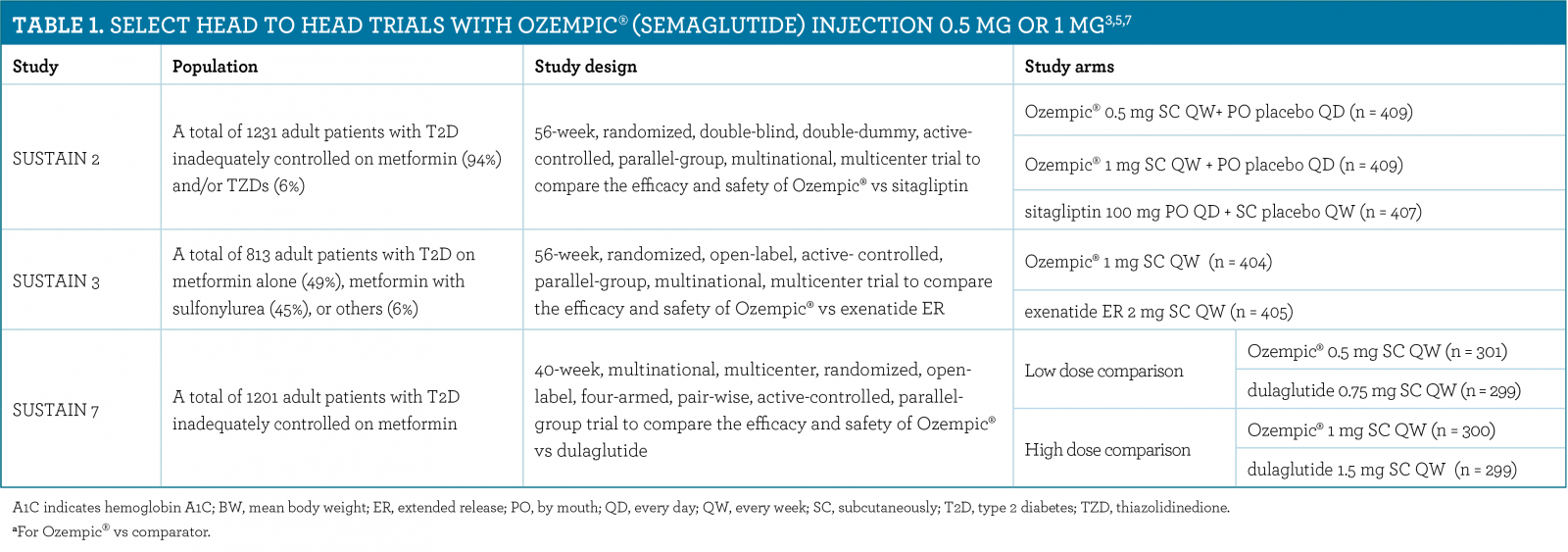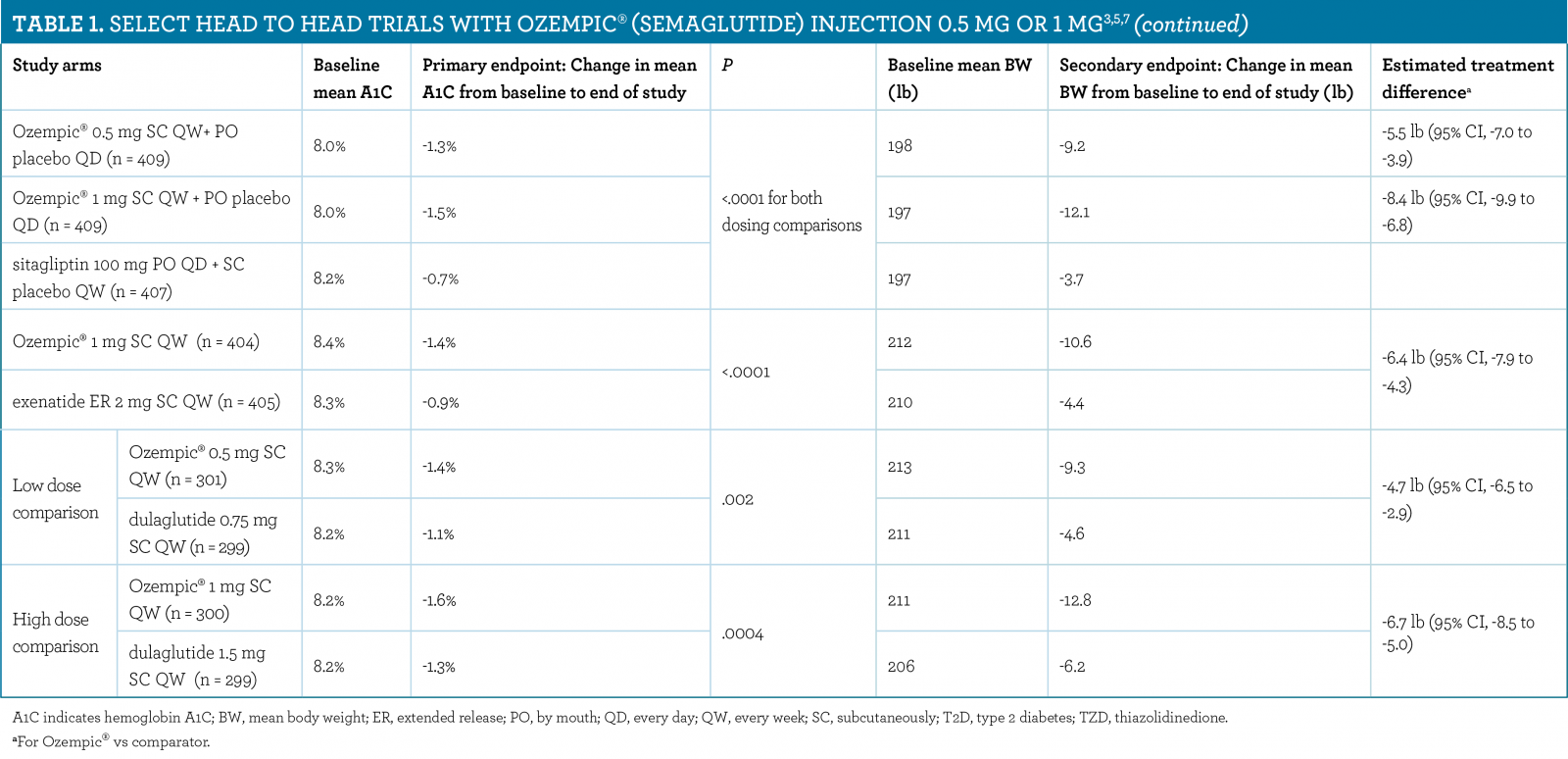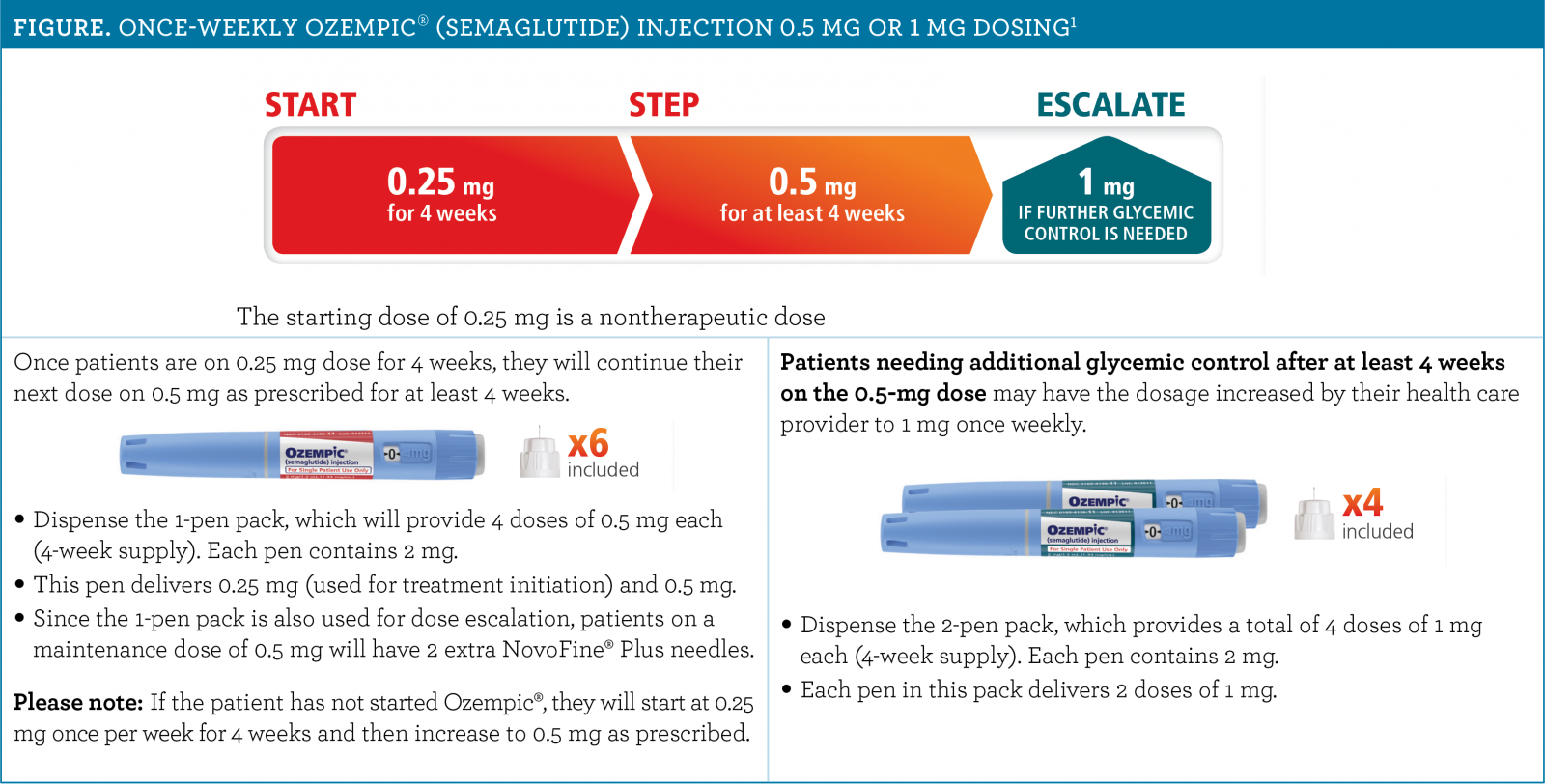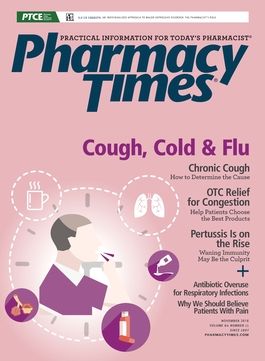Publication
Article
Pharmacy Times
A Pharmacist's Guide to Counseling Patients on a Once-Weekly GLP-1 RA Treatment for Type 2 Diabetes
This article was sponsored by Novo Nordisk.
Please see the Prescribing Information, including Boxed Warning, for Ozempic® (semaglutide) injection 0.5 mg or 1 mg.
Pharmacists are uniquely positioned to answer questions, educate patients, and offer support to patients who are starting or currently using Ozempic® (semaglutide) injection 0.5 mg or 1 mg. During patient counseling, several important points regarding Ozempic® safety and efficacy, recommended dosing and administration, and patient support resources can be discussed.
Indication
Ozempic® (semaglutide) injection 0.5 mg or 1 mg is a once-weekly injectable glucagon-like peptide 1 (GLP-1) receptor agonist (RA) indicated as an adjunct to diet and exercise to improve glycemic control in adults with type 2 diabetes mellitus (T2D).1
Limitations of Use
• Ozempic® is not recommended as a first-line therapy for patients who have inadequate glycemic control on diet and exercise because of the uncertain relevance of rodent C-cell tumor findings to humans.
• Ozempic® has not been studied in patients with a history of pancreatitis. Consider other antidiabetic therapies in patients with a history of pancreatitis.
• Ozempic® is not a substitute for insulin. Ozempic® is not indicated for use in patients with type 1 diabetes mellitus or for the treatment of patients with diabetic ketoacidosis, as it would not be effective in these settings.
Important Safety Information
WARNING: RISK OF THYROID C-CELL TUMORS
• In rodents, semaglutide causes dose-dependent and treatment-duration-dependent thyroid C-cell tumors at clinically relevant exposures. It is unknown whether Ozempic® causes thyroid C-cell tumors, including medullary thyroid carcinoma (MTC), in humans as human relevance of semaglutide-induced rodent thyroid C-cell tumors has not been determined.
• Ozempic® is contraindicated in patients with a personal or family history of MTC and in patients with Multiple Endocrine Neoplasia syndrome type 2 (MEN 2). Counsel patients regarding the potential risk for MTC with the use of Ozempic® and inform them of symptoms of thyroid tumors (e.g. a mass in the neck, dysphagia, dyspnea, persistent hoarseness). Routine monitoring of serum calcitonin or using thyroid ultrasound is of uncertain value for early detection of MTC in patients treated with Ozempic®.
Please see additional Important Safety Information below.
Mechanism of Action
Ozempic® reduces blood glucose through a mechanism where it stimulates insulin secretion and lowers glucagon secretion, both in a glucose-dependent manner. When blood glucose is high, insulin secretion is stimulated and glucagon secretion is inhibited. The mechanism of blood glucose lowering with Ozempic® also involves a minor delay in gastric emptying in the early postprandial phase.1
Superior Efficacy in A1C and Weight Reduction With Ozempic®
Across 3 SUSTAIN trials, listed in
TABLE 1
, Ozempic® demonstrated superiority in A1C reduction and the secondary endpoint of mean change in body weight in adult patients with T2D. The trials compared Ozempic® to dulaglutide (Trulicity®), extended-release exenatide (Bydureon®), and sitagliptin (Januvia®).2-7 Ozempic® is not indicated for weight loss.


Important Safety Information (cont'd)
Contraindications
Ozempic® is contraindicated in patients with a personal or family history of MTC or in patients with MEN 2, and in patients with known hypersensitivity to semaglutide or to any of the product components.
Warnings and Precautions
- Risk of Thyroid C-Cell Tumors: Patients should be referred to an endocrinologist for further evaluation if serum calcitonin is measured and found to be elevated or thyroid nodules are noted on physical examination or neck imaging.
- Pancreatitis: Acute and chronic pancreatitis have been reported in clinical studies. Observe patients carefully for signs and symptoms of pancreatitis (persistent severe abdominal pain, sometimes radiating to the back with or without vomiting). If pancreatitis is suspected, discontinue Ozempic® promptly, and if pancreatitis is confirmed, do not restart.
- Diabetic Retinopathy Complications: In a 2-year trial involving patients with type 2 diabetes and high cardiovascular risk, more events of diabetic retinopathy complications occurred in patients treated with Ozempic® (3.0%) compared to placebo (1.8%). The absolute risk increase for diabetic retinopathy complications was larger among patients with a history of diabetic retinopathy at baseline than among patients without a known history of diabetic retinopathy. Rapid improvement in glucose control has been associated with a temporary worsening of diabetic retinopathy. The effect of long-term glycemic control with semaglutide on diabetic retinopathy complications has not been studied. Patients with a history of diabetic retinopathy should be monitored for progression of diabetic retinopathy.
- Never Share an Ozempic® Pen Between Patients: Ozempic® pens must never be shared between patients, even if the needle is changed. Pen-sharing poses a risk for transmission of blood-borne pathogens.
Please see additional Important Safety Information below.
Cardiovascular Outcomes Trial Data With Ozempic®
Per FDA guidance issued in 2008, new antidiabetic therapies must demonstrate that treatment is not associated with an unacceptable increase in cardiovascular (CV) risk.8 The SUSTAIN 6 trial was designed to rule out excess CV risk associated with Ozempic® plus standard of care (SOC) vs SOC alone by excluding the preapproval non inferiority margin of 1.8 set by the FDA. This 2-year, randomized, multinational, multicenter, double-blind, placebo-controlled, parallel-group, CV outcomes trial randomized patients with T2D who had established CV risk (1:1:1:1) to once-weekly treatment with subcutaneously administered Ozempic® 0.5 mg or 1 mg plus CV and diabetes SOC or SOC alone (placebo) (N = 3297).9
Results from the SUSTAIN 6 trial demonstrated noninferiority of Ozempic® compared with placebo with regard to first major adverse CV events (MACE) of CV death, nonfatal myocardial infarction, or nonfatal stroke.1,9 At the end of the trial, the total number of primary composite MACE endpoints was 108 (6.6%) with Ozempic® and 146 (8.9%) with placebo. There were 26% fewer MACE with Ozempic® vs SOC, which helped establish no increased risk for MACE. Ozempic® is not indicated for the reduction of MACE and there have been no studies establishing conclusive evidence of macrovascular risk reduction.1,9 Patients were at high CV risk and followed for a relatively short duration (2.1 years). Whether these results would be equivalent in a general patient population is unknown.1
Safety Considerations
TABLE 2
shows common adverse reactions (ARs), excluding hypoglycemia, associated with the use of Ozempic® (semaglutide) injection 0.5 mg or 1 mg in the pool of placebo-controlled trials. The most common ARs reported in ≥5% of patients treated with Ozempic® were nausea, vomiting, diarrhea, abdominal pain, and constipation.1
In placebo-controlled trials, the incidence of severe hypoglycemia was <2%. The risk of hypoglycemia is increased when Ozempic® is used in combination with insulin secretagogues (eg, sulfonylureas) or insulin. The risk of hypoglycemia may be lowered by a reduction in the dose of the secretagogue or insulin.1

Practical Considerations
The Ozempic® pen is designed to deliver multiple doses and is supplied with NovoFine® Plus needles, so no additional prescription or copayment is required for needles. Patients should be instructed to take Ozempic® on the same day each week with or without their meals. The day of weekly administration can be changed if necessary as long as the time between two doses is at least 2 days (>48 hours).1
Patients start Ozempic® with a dose of 0.25 mg once weekly. After 4 weeks, the dose is increased to the therapeutic dose of 0.5 mg once weekly. Patients can remain on 0.5 mg or escalate up to the 1 mg dose if additional glycemic control is needed. This gradual dose escalation is designed to help patients adjust to therapy. The maximum recommended dosage is 1 mg once weekly. Please refer to the FIGURE for information on once-weekly Ozempic® dosing.1
Pharmacists may encounter patients who have received a free Ozempic® 6-week starter kit from their health care provider. The starter kit includes a 6-week Ozempic® starter pen, NovoFine® Plus needles, instructions on how to use the Ozempic® pen, information on the Cornerstones4Care® Diabetes Health Coach support program, and an Ozempic® Savings Card that offers copay assistance for refills.

Important Topics to Note for Pharmacists
As part of counseling, pharmacists may have the Pharmacist Counseling Kit with an Ozempic® demonstation pen, which can be used to teach proper assembly and injection technique. At initial Ozempic® dispensing and all refills, patients should be reminded that a new pen needle must be used with each dose and used needles are discarded after each dose.
Pharmacists can counsel patients on the most common ARs with Ozempic® and encourage discussion regarding potential ARs, especially gastrointestinal-related symptoms.1 Additional important counseling points for Ozempic® are summarized in
TABLE 2
.1
Important Safety Information (cont'd)
Warnings and Precautions (cont'd)
- Hypoglycemia: The risk of hypoglycemia is increased when Ozempic® is used in combination with insulin secretagogues (e.g., sulfonylureas) or insulin.
- Acute Kidney Injury: There have been postmarketing reports of acute kidney injury and worsening of chronic renal failure, which may sometimes require hemodialysis, in patients treated with GLP-1 receptor agonists. Some of these events have been reported in patients without known underlying renal disease. A majority of the reported events occurred in patients who had experienced nausea, vomiting, diarrhea, or dehydration. Monitor renal function when initiating or escalating doses of Ozempic® in patients reporting severe adverse gastrointestinal reactions.
- Hypersensitivity: Serious hypersensitivity reactions (e.g., anaphylaxis, angioedema) have been reported with GLP-1 receptor agonists. If hypersensitivity reactions occur, discontinue use of Ozempic®; treat promptly per standard of care, and monitor until signs and symptoms resolve. Use caution in a patient with a history of angioedema or anaphylaxis with another GLP-1 receptor agonist.
- Macrovascular Outcomes: There have been no clinical studies establishing conclusive evidence of macrovascular risk reduction with Ozempic®
Adverse Reactions
- The most common adverse reactions, reported in ≥5% of patients treated with Ozempic® are nausea, vomiting, diarrhea, abdominal pain, and constipation
Drug Interactions
- The risk of hypoglycemia may be lowered by a reduction in the dose of the secretagogue or insulin.
- Ozempic® causes a delay of gastric emptying and has the potential to impact the absorption of concomitantly administered oral medications, so caution should be exercised.
Use in Specific Populations
- There are limited data with semaglutide use in pregnant women to inform a drug-associated risk for adverse developmental outcomes. Discontinue Ozempic® in women at least 2 months before a planned pregnancy due to the long washout period for semaglutide.
Please see the Prescribing Information, including Boxed Warning, for Ozempic® (semaglutide) Injection 0.5 mg or 1 mg.
References
1. Ozempic [prescribing information]. Plainsboro, NJ: Novo Nordisk Inc.; 2017. www.novo-pi.com/ozempic.pdf. Accessed November 28, 2018.
2. Trulicity [prescribing information]. Indianapolis, IN: Eli Lilly and Company; 2017. www.accessdata.fda.gov/drugsatfda_docs/label/2017/125469s007s008lbl.pdf. Accessed November 28, 2018.
3. Ahrén B, Masmiquel L, Kumar H, et al. Efficacy and safety of once-weekly semaglutide versus once-daily sitagliptin as an add-on to metformin, thiazolidinediones, or both, in patients with type 2 diabetes (SUSTAIN 2): a 56-week, double blind, phase 3a, randomised trial. Lancet Diabetes Endocrinol. 2017;5(5):341-354. doi: 10.1016/S2213-8587(17)30092-X.
4. Bydureon [prescribing information]. Wilmington, DE: AstraZeneca LP; 2018. www.azpicentral.com/bydureon_bcise/bydureon_bcise_pi.pdf. Accessed November 28, 2018.
5. Ahmann AJ, Capehorn M, Charpentier G, et al. Efficacy and safety of once-weekly semaglutide versus exenatide ER in subjects with type 2 diabetes (SUSTAIN 3): a 56-week, open-label, randomized clinical trial. Diabetes Care. 2018;41(2):258-266. doi: 10.2337/dc17-0417.
6. Januvia [prescribing information]. Whitehouse Station, NJ: Merck & Co., Inc.; 2018.www.merck.com/product/usa/pi_circulars/j/januvia/januvia_pi.pdf. Accessed November 28, 2018.
7. Pratley RE, Aroda VR, Lingvay I, et al. Semaglutide versus dulaglutide once weekly in patients with type 2 diabetes (SUSTAIN 7): a randomised, open-label, phase 3b trial. Lancet Diabetes Endocrinol. 2018;6(4):275-286. doi: 10.1016/S2213-8587(18)30024-X.
8. FDA. Guidance for industry: diabetes mellitus—evaluating cardiovascular risk in new antidiabetic therapies to treat type 2 diabetes. FDA website. www.fda.gov/downloads/drugs/guidancecomplianceregulatoryinformation/guidances/ucm071627.pdf. Published December 2008. Accessed September 1, 2018.
9. Marso SP, Bain SC, Consoli A, et al; SUSTAIN-6 Investigators. Semaglutide with cardiovascular outcomes in patients with type 2 diabetes. N Eng J Med. 2016;375(19):1834-1844. doi: 10.1056/NEJMoa1607141.
Ozempic® is a registered trademark of Novo Nordisk A/S.
Novo Nordisk is a registered trademark of Novo Nordisk A/S.
All other trademarks, registered or unregistered, are the property of their respective owners.
© 2018 Novo Nordisk US18OZM00521 12/2018







